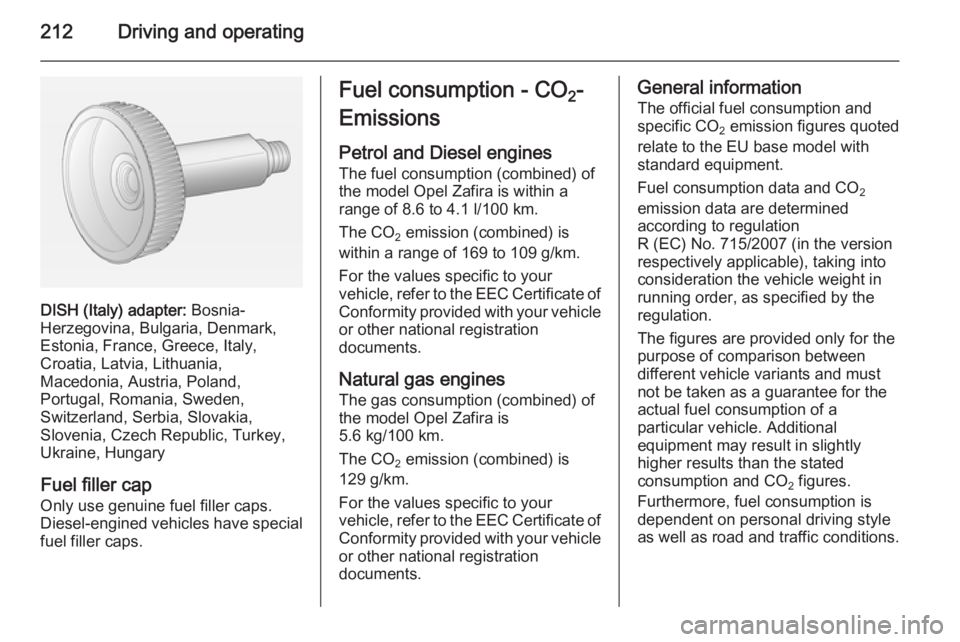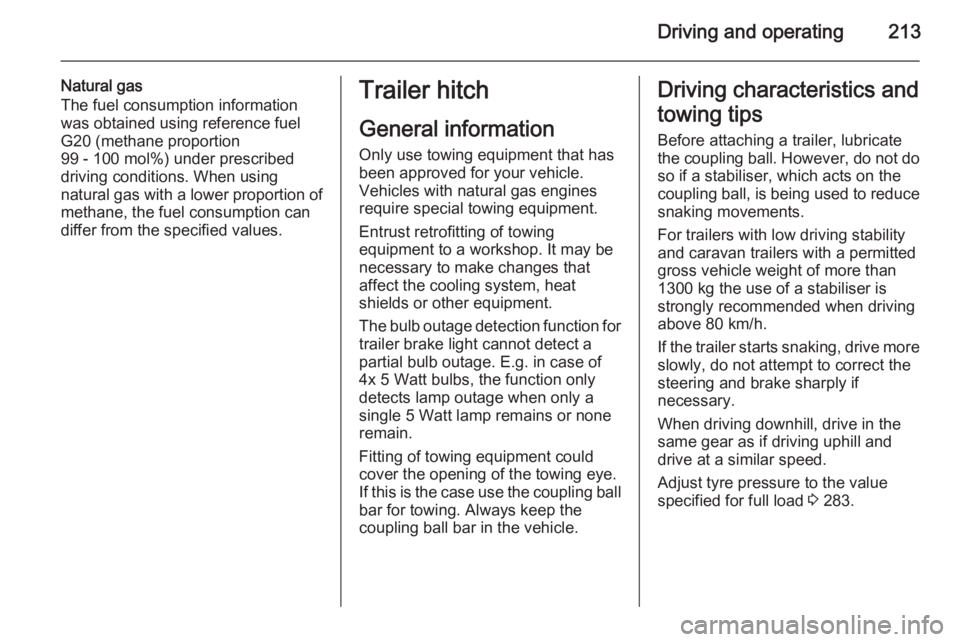2015 OPEL ZAFIRA TOURER fuel consumption
[x] Cancel search: fuel consumptionPage 214 of 299

212Driving and operating
DISH (Italy) adapter: Bosnia-
Herzegovina, Bulgaria, Denmark,
Estonia, France, Greece, Italy,
Croatia, Latvia, Lithuania,
Macedonia, Austria, Poland,
Portugal, Romania, Sweden,
Switzerland, Serbia, Slovakia,
Slovenia, Czech Republic, Turkey,
Ukraine, Hungary
Fuel filler cap
Only use genuine fuel filler caps. Diesel-engined vehicles have special fuel filler caps.
Fuel consumption - CO 2-
Emissions
Petrol and Diesel engines
The fuel consumption (combined) of
the model Opel Zafira is within a
range of 8.6 to 4.1 l/100 km.
The CO 2 emission (combined) is
within a range of 169 to 109 g/km.
For the values specific to your
vehicle, refer to the EEC Certificate of Conformity provided with your vehicle
or other national registration
documents.
Natural gas engines The gas consumption (combined) of
the model Opel Zafira is
5.6 kg/100 km.
The CO 2 emission (combined) is
129 g/km.
For the values specific to your
vehicle, refer to the EEC Certificate of
Conformity provided with your vehicle or other national registration
documents.General information
The official fuel consumption and
specific CO 2 emission figures quoted
relate to the EU base model with
standard equipment.
Fuel consumption data and CO 2
emission data are determined
according to regulation
R (EC) No. 715/2007 (in the version
respectively applicable), taking into
consideration the vehicle weight in
running order, as specified by the
regulation.
The figures are provided only for the
purpose of comparison between
different vehicle variants and must
not be taken as a guarantee for the
actual fuel consumption of a
particular vehicle. Additional
equipment may result in slightly
higher results than the stated
consumption and CO 2 figures.
Furthermore, fuel consumption is
dependent on personal driving style
as well as road and traffic conditions.
Page 215 of 299

Driving and operating213
Natural gas
The fuel consumption information
was obtained using reference fuel
G20 (methane proportion
99 - 100 mol%) under prescribed
driving conditions. When using
natural gas with a lower proportion of
methane, the fuel consumption can
differ from the specified values.Trailer hitch
General information
Only use towing equipment that has
been approved for your vehicle.
Vehicles with natural gas engines
require special towing equipment.
Entrust retrofitting of towing
equipment to a workshop. It may be
necessary to make changes that
affect the cooling system, heat
shields or other equipment.
The bulb outage detection function for
trailer brake light cannot detect a
partial bulb outage. E.g. in case of
4x 5 Watt bulbs, the function only
detects lamp outage when only a
single 5 Watt lamp remains or none
remain.
Fitting of towing equipment could
cover the opening of the towing eye.
If this is the case use the coupling ball bar for towing. Always keep the
coupling ball bar in the vehicle.Driving characteristics and
towing tips Before attaching a trailer, lubricatethe coupling ball. However, do not do
so if a stabiliser, which acts on the coupling ball, is being used to reduce snaking movements.
For trailers with low driving stability
and caravan trailers with a permitted
gross vehicle weight of more than
1300 kg the use of a stabiliser is
strongly recommended when driving
above 80 km/h.
If the trailer starts snaking, drive more slowly, do not attempt to correct the
steering and brake sharply if
necessary.
When driving downhill, drive in the
same gear as if driving uphill and
drive at a similar speed.
Adjust tyre pressure to the value
specified for full load 3 283.
Page 245 of 299

Vehicle care243Tyre designationsE.g. 215/60 R 16 95 H215=Tyre width, mm60=Cross-section ratio (tyre height
to tyre width), %R=Belt type: RadialRF=Type: RunFlat16=Wheel diameter, inches95=Load index e.g. 95 is
equivalent to 690 kgH=Speed code letter
Speed code letter:
Q=up to 160 km/hS=up to 180 km/hT=up to 190 km/hH=up to 210 km/hV=up to 240 km/hW=up to 270 km/h
Directional tyres
Fit directional tyres such that they rollin the direction of travel. The rolling
direction is indicated by a symbol
(e.g. an arrow) on the sidewall.
Tyre pressure
Check the pressure of cold tyres at least every 14 days and before any
long journey. Do not forget the spare
wheel. This also applies to vehicles
with tyre pressure monitoring system.
Unscrew the valve cap.
Tyre pressure 3 283.
The tyre pressure information label
on the front left or right door frame
indicates the original equipment tyres
and the correspondent tyre
pressures.
The tyre pressure data refers to cold
tyres. It applies to summer and winter tyres.
Always inflate the spare tyre to the
pressure specified for full load.
The ECO tyre pressure serves to
achieve the smallest amount of fuel
consumption possible.
Incorrect tyre pressures will impair
safety, vehicle handling, comfort and
fuel economy and will increase tyre
wear.
Tyre pressures differ depending on
various options. For the correct tyre
pressure value, follow the procedure
below:
1. Identify the engine identifier code.
Engine data 3 273.
2. Identify the respective tyre.
The tyre pressure tables show all possible tyre combinations 3 283.
For the tyres approved for your
vehicle, refer to the EEC Certificate of
Conformity provided with your vehicle
or other national registration
documents.
Page 275 of 299
![OPEL ZAFIRA TOURER 2015 Owners Manual Technical data273Engine dataSales designation1.41.41.4 LPG1.6 CNGEngine identifier codeB14NELB14NETB14NETB16XNTNumber of cylinders4444Piston displacement [cm3
]1364136413641598Engine power [kW]8810310 OPEL ZAFIRA TOURER 2015 Owners Manual Technical data273Engine dataSales designation1.41.41.4 LPG1.6 CNGEngine identifier codeB14NELB14NETB14NETB16XNTNumber of cylinders4444Piston displacement [cm3
]1364136413641598Engine power [kW]8810310](/manual-img/37/58243/w960_58243-274.png)
Technical data273Engine dataSales designation1.41.41.4 LPG1.6 CNGEngine identifier codeB14NELB14NETB14NETB16XNTNumber of cylinders4444Piston displacement [cm3
]1364136413641598Engine power [kW]88103103110at rpm4200-60004900-600049005000Torque [Nm]200200200210at rpm1850-42001850-49001850-49002300Fuel typePetrolPetrolLiquid gas/PetrolNatural gas/PetrolOctane rating RONrecommended95959595possible98989898possible91919191Gas––LPGCNGEngine oil consumption [l/1000 km] 2)0.60.60.60.62)
Maximum value.
Page 276 of 299
![OPEL ZAFIRA TOURER 2015 Owners Manual 274Technical data
Sales designation1.61.61.81.8Engine identifier codeA16SHTA16XHTA18XELA18XERNumber of cylinders4444Piston displacement [cm3
]1598159817961796Engine power [kW]14712585103at rpm55006000 OPEL ZAFIRA TOURER 2015 Owners Manual 274Technical data
Sales designation1.61.61.81.8Engine identifier codeA16SHTA16XHTA18XELA18XERNumber of cylinders4444Piston displacement [cm3
]1598159817961796Engine power [kW]14712585103at rpm55006000](/manual-img/37/58243/w960_58243-275.png)
274Technical data
Sales designation1.61.61.81.8Engine identifier codeA16SHTA16XHTA18XELA18XERNumber of cylinders4444Piston displacement [cm3
]1598159817961796Engine power [kW]14712585103at rpm5500600056006300Torque [Nm]280260175175at rpm1650-35001650-320038003800Fuel typePetrolPetrolPetrolPetrolOctane rating RONrecommended98989595possible95959898possible91919191Gas––––Engine oil consumption [l/1000 km] 2)0.60.60.60.62)
Maximum value.
Page 277 of 299
![OPEL ZAFIRA TOURER 2015 Owners Manual Technical data275
Sales designation1.6 Turbo1.6 Turbo2.0 Turbo2.0 TurboEngine identifier codeB16DTHB16DTJA20DTLA20DTNumber of cylinders4444Piston displacement [cm3
]1598159819561956Engine power [kW]10 OPEL ZAFIRA TOURER 2015 Owners Manual Technical data275
Sales designation1.6 Turbo1.6 Turbo2.0 Turbo2.0 TurboEngine identifier codeB16DTHB16DTJA20DTLA20DTNumber of cylinders4444Piston displacement [cm3
]1598159819561956Engine power [kW]10](/manual-img/37/58243/w960_58243-276.png)
Technical data275
Sales designation1.6 Turbo1.6 Turbo2.0 Turbo2.0 TurboEngine identifier codeB16DTHB16DTJA20DTLA20DTNumber of cylinders4444Piston displacement [cm3
]1598159819561956Engine power [kW]100888196at rpm3500-4000400040004000Torque [Nm]320320260300at rpm200020001750-25001750-2500Fuel typeDieselDieselDieselDieselEngine oil consumption [l/1000 km] 2)0.60.60.60.62)
Maximum value.Sales designation2.0 Turbo2.0 Turbo2.0 BiTurboEngine identifier codeA20DTHA20DTHA20DTRNumber of cylinders444Piston displacement [cm 3
]195619561956Engine power [kW]12196143at rpm400040004000
Page 278 of 299
![OPEL ZAFIRA TOURER 2015 Owners Manual 276Technical data
Sales designation2.0 Turbo2.0 Turbo2.0 BiTurboEngine identifier codeA20DTHA20DTHA20DTRTorque [Nm]350300400at rpm1750-25001750-25001750-2500Fuel typeDieselDieselDieselEngine oil consu OPEL ZAFIRA TOURER 2015 Owners Manual 276Technical data
Sales designation2.0 Turbo2.0 Turbo2.0 BiTurboEngine identifier codeA20DTHA20DTHA20DTRTorque [Nm]350300400at rpm1750-25001750-25001750-2500Fuel typeDieselDieselDieselEngine oil consu](/manual-img/37/58243/w960_58243-277.png)
276Technical data
Sales designation2.0 Turbo2.0 Turbo2.0 BiTurboEngine identifier codeA20DTHA20DTHA20DTRTorque [Nm]350300400at rpm1750-25001750-25001750-2500Fuel typeDieselDieselDieselEngine oil consumption [l/1000 km]2)0.60.60.62)
Maximum value.
Page 295 of 299

293
Child restraints.............................. 58
Child restraint systems ................58
Cigarette lighter .........................101
Climate control ............................. 16
Climate control systems .............145
Clock............................................. 99
Code ........................................... 121
Control indicators........................ 105
Control of the vehicle .................154
Controls ........................................ 94
Convex shape .............................. 29
Coolant and antifreeze ...............266
Cruise control ....................114, 174
Cupholders .................................. 64
Curtain airbag system .................. 56
Curve lighting.............................. 136
D Danger, Warnings and Cautions ...4
Daytime running lights ...............136
Declaration of conformity ............287
DEF ............................................ 161
Diesel exhaust fluid ....................161
Diesel fuel system bleeding .......226
Diesel particle filter .............112, 160
Door open .................................. 114
Door panel storage .......................65
Doors ............................................ 25
Driver assistance systems ..........174
Driver Information Centre ...........115Driving characteristics and
towing tips .............................. 213
Driving hints ................................ 154
E Electric adjustment ......................29
Electrical system......................... 235
Electric parking brake .........110, 169
Electric parking brake fault .........110
Electronic climate control system 147
Electronic driving programmes ..166
Electronic Stability Control.......... 172
Electronic Stability Control and Traction Control system ..........112
Electronic Stability Control off..... 112
End-of-life vehicle recovery .......219
Engine compartment fuse box ...237
Engine coolant ........................... 222
Engine coolant temperature gauge ..................................... 104
Engine data ............................... 273
Engine exhaust .......................... 160
Engine identification ...................269
Engine oil ................... 220, 266, 270
Engine oil pressure ....................113
Entry lighting .............................. 143
Event data recorders ..................289
Exit lighting ................................ 143
Exterior care .............................. 261
Exterior light ............................... 113Exterior lighting ....................13, 133
Exterior mirrors ............................. 29
F
Fault ........................................... 166
First aid kit ................................... 90
Fixed air vents ........................... 152
Flex-Fix system ............................ 68
Fog light ..................................... 114
Fog lights ................................... 230
Folding mirrors ............................. 29
Folding tray .................................. 90
Following distance indication ......187
Forward collision alert................. 184
Front airbag system .....................54
Front fog lights ........................... 140
Front seats.................................... 38
Front storage ................................ 65
Fuel............................................. 204
Fuel consumption - CO 2-
Emissions ............................... 212
Fuel for diesel engines ..............204
Fuel for liquid gas operation .......205
Fuel for natural gas operation ...204
Fuel for petrol engines ...............204
Fuel gauge ................................. 103
Fuel selector .............................. 103
Fuses ......................................... 235